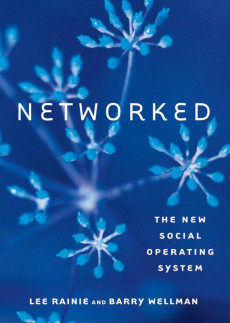By the end of 2012 there will be more mobile devices than people on the planet. This data point from Cisco Systems about our changing world is not mentioned in Lee Rainie and Barry Wellman’s excellent new book. There are two reasons for the omission: First, the statistic about cell phones is global, and Rainie and Wellman’s research focuses on North America. Second, the stat doesn’t come from either of their institutions, Pew Research Center’s Internet & American Life Project (Rainie) and NetLab at the University of Toronto (Wellman).
Just about every other fact—both quantitative and qualitative—about how the Internet (particularly broadband), mobile phones, and social networking are changing our lives can be found in Networked. The book provides analysis of the mounds of data they have collected over the years and weaves an argument that should have a long tablet life.
Rainie and Wellman do this by firmly anchoring the vast amount of survey data that Pew collects and the ethnographic research conducted by NetLab in a long view of institutional change. Social networking does not begin with Facebook, they argue. Facebook is merely this moment’s representation of a much longer set of behaviors.
Now, Rainie and Wellman argue, we are experiencing a “triple revolution” wrought by the advent of broadband Internet access, social networks, and mobile technologies.The mutually reinforcing and accelerating nature of these technologies is shifting the center of gravity in how we organize as a society. Institutions—both formal, such as schools, and informal, such as families—were once at the center of our societies. Now we are. Each of us, with our mobile phones, is connecting across and within institutional boundaries. The result, which the authors call “networked individualism,” is profound. Where we once organized our communities, work, family, educational, and governance systems around institutions, we are increasingly navigating the world as connected individuals. The authors support this assertion with data and ethnographic research on device usage, information navigation, workplace changes, and economic influence.
One change that Rainie and Wellman point to is the loss of the family telephone. Americans and Canadians increasingly rely on cell phones, and more of us are cutting our landlines. As we do, each member of the household becomes, in effect, her own number. With this comes an increasing flexibility. It also signals one more way in which these technologies can atomize our behavior.
I picked this example from the many presented in the book because it seems so insignificant, so tiny. But the cumulative impact of mobile broadband is being built on change at this minute level. Because of the ease of connecting, we are members of many more groups today, but our engagement lasts for shorter periods of time. We belong to many communities and shift our allegiances to institutions much faster and more often.
A society organized around individuals may need different rules from one organized around institutions. We can see signs of this in philanthropy and social enterprise. Crowdfunding platforms cater to individual projects and the networks of people they can motivate to support them—no intermediary organization is needed. Flash mobs of activists, whether taking on dictatorial governments or cleaning beaches, rely on connections across diverse networks of individuals, not on organizational databases.
The Canadian-American novelist William Gibson has said, “The future is already here—it’s just not very evenly distributed.” Rainie and Wellman’s data clearly show the benefits from the triple revolution of broadband Internet, social networks, and mobile technologies. But the same factors that make networks powerful—their reach and diversity—make exclusion from them problematic. Pew and NetLab will continue to track the spread of these tools and postulate the benefits of access to them. But who will analyze those left out of the networks? And will the disruptive nature of these networks on the workplace, education, health care, information, and governance make it harder for the non-networked to catch up? The growth of the networks is exponential. What needs to be done to make sure the effects of exclusion are not also exponential, creating a chasm that cannot be bridged?


